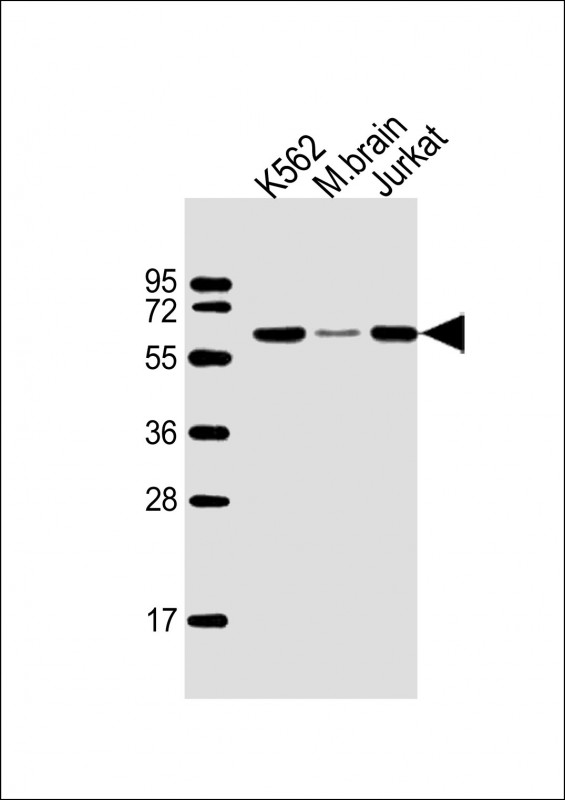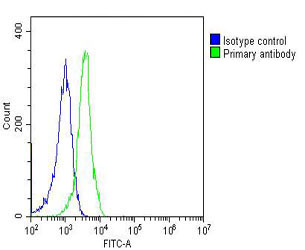USP14 Antibody (N-term)
Mouse Monoclonal Antibody (Mab)
- SPECIFICATION
- CITATIONS
- PROTOCOLS
- BACKGROUND

Application
| WB, FC |
|---|---|
| Primary Accession | P54578 |
| Reactivity | Human, Mouse, Rat |
| Host | Mouse |
| Clonality | Monoclonal |
| Calculated MW | H=56;M=56;Rat=56 KDa |
| Isotype | IgG1 |
| Antigen Source | Human |
| Gene ID | 9097 |
|---|---|
| Antigen Region | 1-474 aa |
| Other Names | USP14;TGT; Ubiquitin carboxyl-terminal hydrolase 14; Ubiquitin carboxyl-terminal hydrolase 14; Deubiquitinating enzyme 14; Ubiquitin carboxyl-terminal hydrolase 14; Ubiquitin thioesterase 14; Ubiquitin carboxyl-terminal hydrolase 14; Ubiquitin-specific-processing protease 14 |
| Dilution | WB~~1:1000 FC~~1:25 |
| Target/Specificity | Purified His-tagged USP14 protein was used to produced this monoclonal antibody. |
| Format | Purified monoclonal antibody supplied in PBS with 0.09% (W/V) sodium azide. This antibody is purified through a protein G column, followed by dialysis against PBS. |
| Storage | Maintain refrigerated at 2-8°C for up to 2 weeks. For long term storage store at -20°C in small aliquots to prevent freeze-thaw cycles. |
| Precautions | USP14 Antibody (N-term) is for research use only and not for use in diagnostic or therapeutic procedures. |
| Name | USP14 |
|---|---|
| Synonyms | TGT |
| Function | Proteasome-associated deubiquitinase which releases ubiquitin from the proteasome targeted ubiquitinated proteins (PubMed:35145029). Ensures the regeneration of ubiquitin at the proteasome (PubMed:18162577, PubMed:28396413). Is a reversibly associated subunit of the proteasome and a large fraction of proteasome-free protein exists within the cell (PubMed:18162577). Required for the degradation of the chemokine receptor CXCR4 which is critical for CXCL12-induced cell chemotaxis (PubMed:19106094). Serves also as a physiological inhibitor of endoplasmic reticulum-associated degradation (ERAD) under the non-stressed condition by inhibiting the degradation of unfolded endoplasmic reticulum proteins via interaction with ERN1 (PubMed:19135427). Indispensable for synaptic development and function at neuromuscular junctions (NMJs) (By similarity). Plays a role in the innate immune defense against viruses by stabilizing the viral DNA sensor CGAS and thus inhibiting its autophagic degradation (PubMed:27666593). Inhibits OPTN-mediated selective autophagic degradation of KDM4D and thereby negatively regulates H3K9me2 and H3K9me3 (PubMed:35145029). |
| Cellular Location | Cytoplasm. Cell membrane; Peripheral membrane protein |

Thousands of laboratories across the world have published research that depended on the performance of antibodies from Abcepta to advance their research. Check out links to articles that cite our products in major peer-reviewed journals, organized by research category.
info@abcepta.com, and receive a free "I Love Antibodies" mug.
Provided below are standard protocols that you may find useful for product applications.
Background
Proteasome-associated deubiquitinase which releases ubiquitin from the proteasome targeted ubiquitinated proteins. Ensures the regeneration of ubiquitin at the proteasome. Is a reversibly associated subunit of the proteasome and a large fraction of proteasome-free protein exists within the cell. Required for the degradation of the chemokine receptor CXCR4 which is critical for CXCL12-induced cell chemotaxis. Serves also as a physiological inhibitor of endoplasmic reticulum-associated degradation (ERAD) under the non-stressed condition by inhibiting the degradation of unfolded endoplasmic reticulum proteins via interaction with ERN1. Indispensable for synaptic development and function at neuromuscular junctions (NMJs).
References
Deshpande K.L., et al. Submitted (AUG-1995) to the EMBL/GenBank/DDBJ databases.
Kalnine N., et al. Submitted (MAY-2003) to the EMBL/GenBank/DDBJ databases.
Reuter T.Y., et al. Exp. Cell Res. 289:211-221(2003).
Carrascal M., et al. J. Proteome Res. 7:5167-5176(2008).
Koulich E., et al. Mol. Biol. Cell 19:1072-1082(2008).
If you have used an Abcepta product and would like to share how it has performed, please click on the "Submit Review" button and provide the requested information. Our staff will examine and post your review and contact you if needed.
If you have any additional inquiries please email technical services at tech@abcepta.com.













 Foundational characteristics of cancer include proliferation, angiogenesis, migration, evasion of apoptosis, and cellular immortality. Find key markers for these cellular processes and antibodies to detect them.
Foundational characteristics of cancer include proliferation, angiogenesis, migration, evasion of apoptosis, and cellular immortality. Find key markers for these cellular processes and antibodies to detect them. The SUMOplot™ Analysis Program predicts and scores sumoylation sites in your protein. SUMOylation is a post-translational modification involved in various cellular processes, such as nuclear-cytosolic transport, transcriptional regulation, apoptosis, protein stability, response to stress, and progression through the cell cycle.
The SUMOplot™ Analysis Program predicts and scores sumoylation sites in your protein. SUMOylation is a post-translational modification involved in various cellular processes, such as nuclear-cytosolic transport, transcriptional regulation, apoptosis, protein stability, response to stress, and progression through the cell cycle. The Autophagy Receptor Motif Plotter predicts and scores autophagy receptor binding sites in your protein. Identifying proteins connected to this pathway is critical to understanding the role of autophagy in physiological as well as pathological processes such as development, differentiation, neurodegenerative diseases, stress, infection, and cancer.
The Autophagy Receptor Motif Plotter predicts and scores autophagy receptor binding sites in your protein. Identifying proteins connected to this pathway is critical to understanding the role of autophagy in physiological as well as pathological processes such as development, differentiation, neurodegenerative diseases, stress, infection, and cancer.




